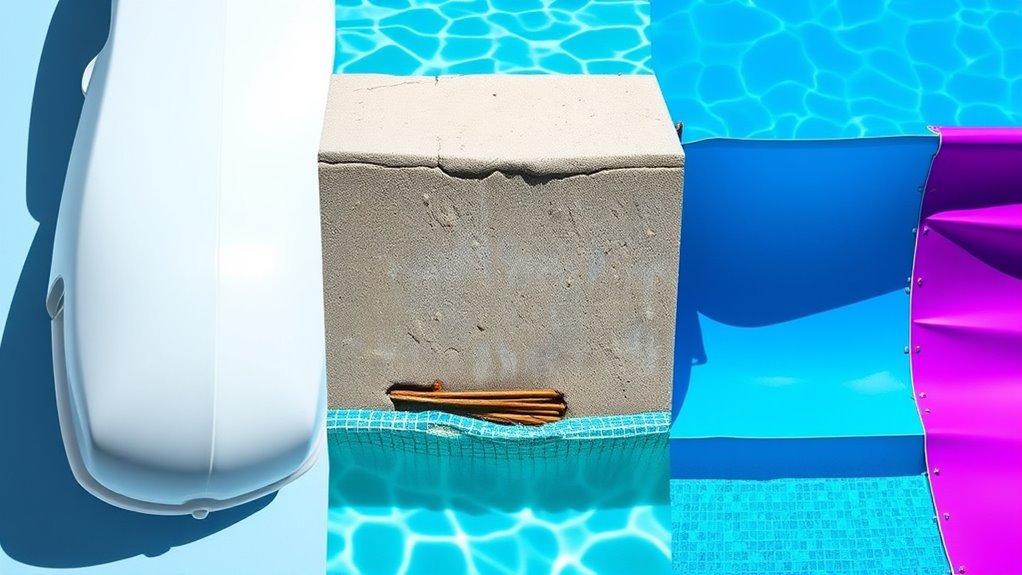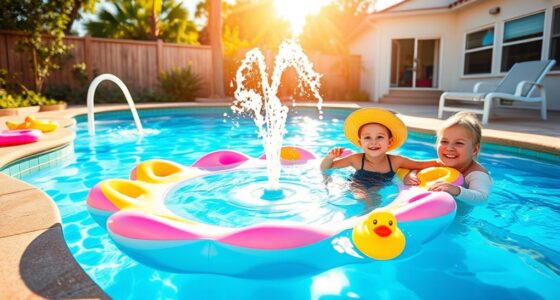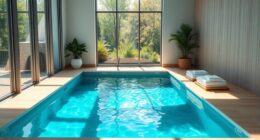When choosing between fiberglass, concrete, and vinyl pools, consider your priorities. Fiberglass pools offer quick installation and low maintenance but are limited in shape options. Concrete pools are highly customizable and durable but come with higher costs and longer setup times. Vinyl pools are budget-friendly with flexible liner choices but may need liner replacements over time. To make the best decision, explore how each option suits your lifestyle and expectations.
Key Takeaways
- Fiberglass pools offer quick installation, low maintenance, and durability, making them ideal for those seeking a hassle-free, long-lasting option.
- Concrete pools provide unlimited design flexibility and durability but involve higher upfront costs and longer construction times.
- Vinyl pools are the most budget-friendly with quick setup but may require liner replacements every 5-10 years, affecting maintenance costs.
- Consider your budget, desired customization, and maintenance preferences when choosing between the low-maintenance fiberglass, customizable concrete, or economical vinyl.
- Overall, fiberglass suits low-maintenance needs, concrete offers design versatility, and vinyl is best for cost-conscious, quick installations.

Choosing the right pool material is essential because it directly impacts durability, maintenance, and overall cost. When deciding between fiberglass, concrete, and vinyl, you need to evaluate how each option affects your pool’s longevity, upkeep, and your budget. Your choice influences how much you’ll spend on pool maintenance over time and the upfront installation costs. Understanding these factors helps you make an informed decision that suits your lifestyle and financial plans.
Choosing the right pool material impacts durability, maintenance, and cost—making informed decisions essential for your lifestyle and budget.
Fiberglass pools are known for their quick installation and smooth surface, which resists algae growth and reduces the need for harsh chemicals. This means less pool maintenance, saving you time and effort. Because fiberglass shells are pre-made and delivered ready to install, their installation costs tend to be lower than concrete but higher than vinyl. However, their durability is impressive—they resist cracking and shifting over time, making them a long-lasting option. If you want a low-maintenance pool that’s ready faster and minimizes ongoing upkeep, fiberglass could be your best choice. Keep in mind, though, that the initial cost can be higher than vinyl, but the reduced maintenance expenses balance this out over the years.
Concrete pools offer unmatched versatility in shape and size, allowing you to customize your design. They are highly durable and can withstand harsh weather conditions, which makes them a solid long-term investment. However, concrete pools require extensive installation work, involving excavation, reinforcement, and finishing, which considerably increases installation costs. The surface of a concrete pool also demands regular maintenance, including resurfacing every 10 years to prevent staining, cracking, or roughening. If you’re inclined toward a highly customized pool and don’t mind the higher upfront investment and ongoing maintenance, concrete can be a rewarding choice. It’s essential to factor in the routine upkeep when evaluating your total pool maintenance costs over its lifespan.
Vinyl pools are typically the most budget-friendly option in terms of installation costs. They come with a flexible liner that’s quick to install, making them an attractive choice for homeowners on a tighter budget. Vinyl pools tend to have lower initial costs but can incur higher maintenance costs over time due to liner replacements, which are necessary every 5 to 10 years depending on usage and wear. Their smooth surface is comfortable and resistant to algae, reducing chemical use. However, the liner can be punctured or stained, requiring repairs or replacements that add to your ongoing pool maintenance expenses. If you prefer a quick, cost-effective setup with manageable maintenance, vinyl pools are a practical option, but keep in mind the potential for future liner replacement costs that may impact your overall budget.
Ultimately, your choice depends on your priorities regarding installation costs, maintenance, and how long you plan to keep the pool. Each material offers distinct benefits and trade-offs, so weigh these carefully to select the pool that best fits your needs.
Frequently Asked Questions
Which Pool Material Is Most Environmentally Friendly?
When considering eco-friendly options for your pool, you want sustainable materials that minimize environmental impact. You might find that concrete pools, made with durable, long-lasting materials, are more sustainable over time. Additionally, some vinyl liners are now produced with eco-conscious processes. However, overall, concrete pools tend to be the most environmentally friendly because they require fewer replacements and less chemical maintenance, making them a better choice for sustainability.
How Do Maintenance Costs Compare Over Time?
Maintenance costs vary depending on your pool material choice. Fiberglass pools tend to have lower long-term costs because of their chemical resistance and minimal upkeep needs. Concrete pools require more frequent resurfacing and sealing, increasing expenses over time. Vinyl liners need replacement every 7-15 years, adding to costs. Consider the longevity comparison; fiberglass generally offers the lowest ongoing maintenance, saving you money, while concrete and vinyl may require more frequent repairs and upkeep.
Are There Aesthetic Limitations for Each Material?
Did you know that fiberglass pools typically come in 10-15 color options, offering limited design flexibility? Vinyl pools also have a range of patterns but fewer customization choices. Concrete pools excel in design flexibility, allowing you to create unique shapes and finishes, though they might lack vibrant color options. So, your aesthetic preferences will influence whether you prioritize variety in color or in overall design.
Which Material Offers the Fastest Installation?
You’ll find that fiberglass pools offer the fastest installation speed, markedly shortening your construction timeline. They come pre-molded, allowing installation within just a few days, unlike concrete or vinyl options, which require extensive construction time. If quick results matter most, fiberglass is your best choice, letting you enjoy your new pool sooner. Be aware that while installation is quick, other factors like customization might influence your decision.
How Well Does Each Material Withstand Extreme Weather?
You’ll find that each pool material offers different levels of weather resistance and durability. Fiberglass pools excel in weather resistance, resisting cracking and damage from extreme conditions. Concrete pools are highly durable but may develop cracks over time if not maintained properly. Vinyl pools, while more flexible, can be less resistant to harsh weather, especially UV rays. Overall, fiberglass generally provides the best pool durability against extreme weather.
Conclusion
Choosing the right pool material is like selecting your own oasis—each option offers its unique charm and character. Whether fiberglass’s smooth finish, concrete’s customizable durability, or vinyl’s affordability, your choice shapes countless summer memories. Remember, the pool you select isn’t just a structure; it’s your personal escape, echoing the timeless allure of a hidden lagoon. So, plunge in your decision with confidence—your perfect retreat awaits, just beyond the surface.









